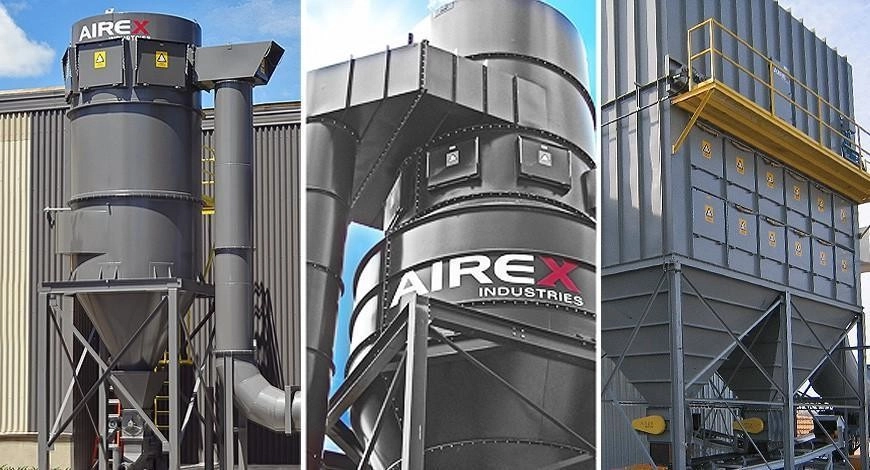
Tips for Choosing the Right Dust Collector
When the time comes to make a final decision on a dust collection system, the wide range of options available can be overwhelming. To help you navigate through them, here is an overview of our experts’ reasoning when selecting a dust collector.
Cartridge Dust Collector
The cartridge dust collector is often our first choice. It’s a compact unit and provides the best price for its airflow rate. This model is easy to maintain and can operate continuously thanks to its compressed air jet cleaning system.
It Is Not Recommended If:
- You have to manage large volumes of dust, because an excessive load can block the system.
- The captured particles have the following properties:
- Fibrous or elongated form, such as paper tabs. They could clog the cartridges without dropping down into the hopper during declogging process.
- Low density. Some dusts (such as cotton wool or micronized glass powder) are too light to counter the upward velocity which, compared with the other models, is higher for a cartridge dust collector. As a result, the particles may prematurely clog the filters.
- Your process generates a lot of heat (if you have a rotary dryer or industrial oven, for example). The heat resistance of the cartridges is limited to 250°F. Since the dust collector’s filters are made of cellulose and polyester, they can be damaged when the temperature reaches a certain threshold.
Shaker Dust Collector
In some cases, we then consider the shaker dust collector, which is not too expensive. This unit is ideal for occasional use: for example, in trade schools or small cabinet-making shops. Also, it’s better to operate this dust collector at a low air-to-cloth ratio, especially when fine dust is present, in order to minimize downtime.
It Is Not Recommended If:
- You cannot do the long periodic shutdowns that are mandatory for cleaning the filter bags because of the lack of a self-cleaning system.
Baghouse Dust Collector – Rectangular
The rectangular baghouse dust collector is often our experts’ second choice. Its filtration-capacity-to-energy-needs ratio puts it among the most efficient ones. It can also be customized in various ways, and its self-cleaning system enables it to be in continuous operation.
Its rectangular design can be adapted to a number of settings because the unit’s design can be adjusted to the environmental constraints. Therefore, it is ideal for confined areas, such as mining tunnels.
This unit is better able to withstand extremely abrasive dusts than a cyclonic system. For example, its design can be reinforced with an abrasion-resistant impact plate, bolted onto the baffle plate at the dust collector’s entrance. This addition prevents early wear on the dust collector and can be changed independently of the rest of the system. It is even possible to add other modules to this model over time, to adjust it to your needs.
It Is Not Recommended If:
- Your process generates a huge amount of dust, like in the wood industry or refineries.
Baghouse Dust Collector with Cyclonic Effect
When the load is too great to be properly managed with a rectangular dust collector, it’s necessary to turn to a unit with cyclonic pre-filtration. This model has two-stage filtering: the cyclonic effect separates and captures the larger particles, then the filter bags take care of the fine dust. Although this unit is a high-performance type, its airflow-based price is high.
It Is Not Recommended If:
- Your environment contains abrasive dusts. Since the cyclonic effect propels the particles against the dust collector walls, it creates friction that can damage the unit and cause premature wear.
- Your space is limited, because this model takes up a lot of room, vertically.
- You have to use a variable frequency drive, because this type of dust collector must definitely maintain a constant airflow rate to support the cyclonic effect.
Wet Dust Collector
Your process produces a significant amount of sparks, like with reworking components, deburring and in smelting operations, or contains highly explosive metals. In this context, dry dust collectors are not feasible solutions, and a wet dust collector is required. It is very compact and is the only option for managing highly explosive particles. With its water bath, the dust-laden stream is submerged, thus preventing an exothermic reaction of the particles.
Its Disadvantages:
- The emissions released into the atmosphere by the immersion-based separation are higher than with a dry-filter dust collection system.
- Since the water becomes contaminated after use, you need to turn to a specialized external maintenance service to dispose of the water and the build-up of muddy sludge.
- This type of unit uses water, a rare commodity in some areas.
Despite this range of options at your fingertips, choosing a solution that fits your budget and meets your needs is no small task. To find the perfect dust collection system for you, call on our experts!
Get in touch with our experts!
